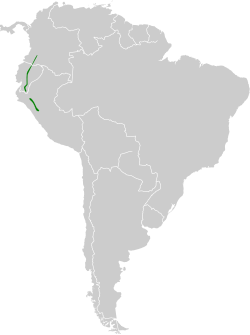| Mountain avocetbill | |
|---|---|
 | |
| Scientific classification | |
| Kingdom: | Animalia |
| Phylum: | Chordata |
| Class: | Aves |
| Clade: | Strisores |
| Order: | Apodiformes |
| Family: | Trochilidae |
| Tribe: | Lesbiini |
| Genus: | Opisthoprora Cabanis & Heine, 1860 |
| Species: | O. euryptera |
| Binomial name | |
| Opisthoprora euryptera (Loddiges, 1832) | |
 | |
The mountain avocetbill (Opisthoprora euryptera) is a species of hummingbird in the "coquettes", tribe Lesbiini of subfamily Lesbiinae. It is found in Colombia, Ecuador, and Peru. [3] [4]








